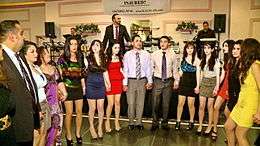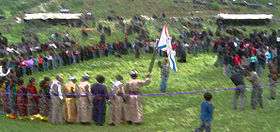Assyrian folk dance

| Assyrian people |
|---|
 |
| Culture |
| Music |
| Language |
| Cuisine |
| Folk Dance |
| Religion |
| Clothing |
| Settlements |
Assyrian Folk Dances are dances that are performed throughout the world by Assyrians, mostly on occasions such as weddings, community parties and other jubilant events.
Assyrian folk dances are mainly made up of circle dances that are performed in a line, which may be straight, curved, or both. Most of the dances allow unlimited number of participants, with the exception of the Sabre Dance, which require three at most. Assyrian dances would vary from weak to strong, depending on the mood and tempo of a song.
Assyrian folk dances belong to five metric groups: 2
4 (10 dances), 4
4 (6 dances), 6
8 (13 dances), 9
8 (1 dance), 10
8 (1 dance). The tempo would usually range from slow (70 Beats Per Minute) to very fast (140 beats).[1][2]
Technique
All Assyrians dances, with the exception of the Sabre Dance, are done in a connected circle. Most Assyrian line dances are itinerant dances and move laterally. In an open floor space, the lines assume open circular shapes where they tend to curve and acquire spiral shapes as determined by floor space availability.[3]
There are only five ways of moving the body; Step, leap, run, hop and jump. The legs are also used to stamp, stomp and kick. The arms are used predominantly and they'd usually move independently of the legs. Arm gestures include bouncing, swinging forward and back, moving side-to-side, lifting above the head and clapping.
In many dances, the torso, along with the shoulders and arms, bounce up and down rhythmically. Stomps and stamps are also executed in Assyrian folk dances. Knee bends, deep squats and leg extensions are a regular occurrence in Assyrian dance.[4]
The connections include, hand-to-hand, hand to shoulder, and hand to hip, with hand-to-hand being the most popular. The hand-to-hand type has three connections; The "W", the "V" and the "T". The "W" arm hold is the most common where the arms are raised into the "W" position (or, at least, it appears to look like the letter W). The "T" dance is where hands are placed on other participants's shoulders. This is the least common dance of the three.[5]
Common Dances

- Khigga: The most popular Assyrian dance. Individuals hold hands with the line following around the dance floor. Khigga is the most simplest of Assyrian folk dance. Its music is the first beat that is played when welcoming the bride and groom to the reception hall. Khigga goes by the time signature of 4
4 with moderate tempo between 105-115bpm. - Siskany: A more fast-paced khigga beat (or "heavy khigga"). Generally, the "normal khigga" beat would gear up to siskany, as a climactic end to the dance. The participants would then shake their shoulders more and move their limbs briskly. The dance is predominantly practiced by Chaldeans. It has an affiliation to the Kurdish dance, since its emphasis is on the shoulders and chest. The pulsating tempo is consanguineous to the electronic dance music and dance-pop found in western music. It goes by the time signature of 4
4 and the tempo is around 120-135bpm. - Sheikhani: A slower paced circle dance. The main movement is two-step. The two-step begins with the right foot (right-left-right) and is then repeated with the left foot (left-right-left). Hands are interlocked, left arm is bent at the elbow and pressed against the back, right arm held forward against the back of the dancer in front. A derivation of this dance, Bagiye, is virtually like Sheikhany but has a move where the dancers reverse the two steps. Sheykhani is 4
4 in time signature and is 75-100bpm. - Gubbare: Usually danced at the end of a party. The music is fast, lively and upbeat. Typically in the major key. Pinkies interlock, dancers repeatedly go forward and back in motion in the circle. Gubareh is in 4
4 and its tempo is around 120-135bmp. - Bablaka: Fast-paced, fervent circle dance. Pinkies interlock where they (hands and arms too) move up and down energetically and perennially.[6] But unlike gubareh, the participant is more stable where they will not prance forward and backwards in the dance floor. Motion is intemperately focused on arms, shoulders and hands in bablaka. Dancers may also rhythmically bend knees. The beat is virtually homogeneous to gubareh. The meter is 4
4 and tempo is around 125-130bpm. - Belaty: The dance is accompanied by a moderately fast-paced Arabic rhythm (similar to belly dancing music). Dancers would connect hand-to-hand in the circle, lift legs to the beat whilst making a slight leap and kick their legs to the sides in the air (this would repeat). The beat is 125-135bpm. 4
4. - Chobi: A modern circle dance found in Iraqi music. It is participated by Iraqi Assyrians. The dance is similar to khigga, but it would have more pronounced leg elevation and swaying. Each leg swiftly kicks to the air and repeats. Arms sway forwards and backwards. The tempo is around 95bpm-100bpm.[7]
- Tanzara: Legend has it that the dance was brought to Anatolia by the Ancient Assyrians during there conquest of the region in the Assyrian empire in commemoration to the god of food and vegetation Tammuz. Dancers connect by holding hands in the circle or line, go forwards and backwards by making a little knee bending. The beat is similar to khigga, though the dance moves differ. The time signature is 2
4 and tempo is 115-125bpm. - Georgina: Slow paced dance, usually accompanied by sentimental ballads that have a Turkish flavour. Dancers hold the pinkie or little finger and move them rhythmically (akin to bablaka, albeit gently). The tempo is around 70bpm-80bpm. 3
4. - Kochari, Moderately fast-paced circle dance. The notable attribute of this dance is that the participants are connected by arms-on-arms (akin to dabke). Each leg makes a kick in a repetitive manner. Common among Assyrians in Syria. Beat is similar to khigga and sheikhani, although it's slightly a bit faster-paced. 2
4, 110-120bmp - Azia Tamma: Similar to sheikhani in terms of pace, but with more steps that go forward and backwards (or reverse) a notch. 2
4, 82-88bpm - Tolama: Lively and energetic dance where the participants constantly jump and kick legs in the air (similar to belaty and gubareh), whilst also moving their torso forward and backwards. 2
4, 120-140bpm - The Sabre Dance: A solo dance that usually involves one to three participants. As the dance starts, the sword bearer dances by himself, waving his sword and holding his shield (a shield is optional, though). The dance represents the symbolic surrender of the bride to the groom and his family. In weddings, it is performed by the closest male relatives of the couple. The rhythm is a 6
8 duple meter, and this gives a "springy" feeling to the dance.[8]
Audio gallery
Audio excerpts of each Assyrian common dance style:
-
A modern Khigga beat with a moderate dance tempo, backed up by electronic drums and synthesizers. This beat is the commonly used style in Assyrian folk dance.
-
A modern Sheikhany rhythm. Laid-back and slower than khigga. Rhythm may be similar to reggaeton and calypso music.
-
The fast-paced, lively Gubare beat. Tends to have an energetic and brisk tone, usually with synthesized traditional music arrangement.
-
The fervidly-paced Siskani beat. Also known as "heavy khigga". Rhythmically and melodically, it bears resemblance to Turkish and Kurdish dance music.
-
The moderately paced Belaty rhythm, which has an Arab pop rhythm.
-
The Georgina beat, which has a slow, leisurely tempo and a maudlin tone.
-
Iraqi Chobi has a relatively slow paced, but rhythmical beat.
-
Acoustic instruments (drum sets, bass guitar) were used up until the early 1990's in live performances. Electronic instruments eventually became ubiquitous by the mid-1990's and replaced the acoustic ones. To note, acoustic instruments are still used in present day, but marginally.
Video gallery
Video excerpts of the common Assyrian dance styles:
-
Khigga
-
Sheikhany
-
Gubbare
-
Belati
-
Bablaka
-
Chobi (with Arabic music)
-
Georgina
-
Tamzara
-
Tolama
-
Azia Tama
-
Kochari
Other dances
These Assyrian folk dances aren't as common, but they're still practiced in marginal communities:
- Janiman: 10
8, 60-66bpm - Mamer: 2
4, 122-130bpm - Arabanoo: 6
8, 52-66bpm - Azrabukeh: 6
8, 116-126bpm - Hareigooleh: 6
8, 116-124bpm - Hoberban: 6
8, 130-134bpm - Zingirta: 2
4, 120-150bpm - Shara: 6
8, 92-100bpm - Dimdimma: 2
4 or 6
8, 72-76 (2
4), 118-122bpm (6
8) - Janiman: 10
8, 60-66bpm - Hoberban: 6
8, 130-134bpm - Mamyana: 2
4, 68-74bpm - Demale: 4
4, 63-69bpm - Chalakhan: 6
8, 126-132bpm - Sinjiyeh
- Bet-Karkhan
- Beriyo
See also
External links
References
- ↑ Stauder, W. Harfen Und Leiern Vorderasiens im Babylonischer under Assyrischer Zeit, s. 51-55, 36-38
- ↑ Andrae, W. Farbige kemik aus Assur, Fig. 29, s.24
- ↑ Engel, Carl. The Musik of the most ancient naton London 1864
- ↑ Anca Giurchescu, Sunni Bloland; Romanian Traditional Dance; Wild Flower Press; Mill Valley, California; 1995
- ↑ Subhi Anwar Rashid, Mesopotamien, Abb 137
- ↑ Rudolf Laban, The Mastery of Movement; Boston: Plays; 1950.
- ↑ Subhi Anwar Rashid, The History of Musical Instruments in Old Iraq, Fig. 41 (In Arabic)
- ↑ Subhi Anwar Rashid, Mesopotamien (Musikgeschichte in Bildern, Leipzig 1984, S. 130 Abb 147










